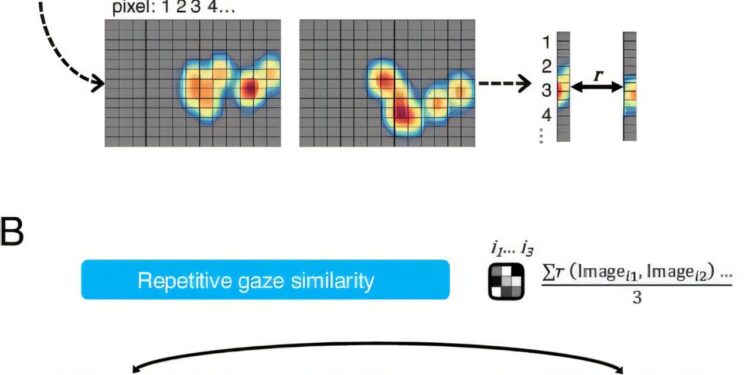A) The fixings belonging to a single participant visualizing a single image are smoothed spatially using a weighted Gaussian nucleus by fixing duration, then vectorized b) The similarity of the idiosyncratic gaze is calculated as the average of the similarity scores obtained by correlating each image with all the other images considered in the same block. Credit: Proceedings of the National Academy of Sciences (2025). DOI: 10.1073 / PNAS. 2005879122
A multi-institution team across Canada and the West Indies reports that look models can serve as a sensitive marker of cognitive decline, with associated discounts in explore, adaptive and differentiated environmental sampling.
Eye movements are closely linked to encoding and recovery processes, changes in visualization behavior often reflecting age and the decline in memory linked to pathology. Previous work has noted that the groups differing in the state of the memory divergent on several characteristics of gaze, which suggests that the metrics of univariate gaze may not fully grasp the complexity of visualization behaviors linked to memory.
In the study, “Decoding of the memory function through models of naturalistic gaze”, published in PNAThe researchers studied changes in naturalist vision behavior in five groups of participants to explore possible indicators based on the look of the memory function.
Two experiences included young adults (Exp 1: n = 35, Exp 2: n = 26), healthy adults in good health (Exp 1: n = 36, Exp 2: n = 28), individuals at risk of significant cognitive decline according to a lower threshold score (<26) on the cognitive assessment of Montreal (Exp 1: N = 12, Exp 2: N = 10) 1: n = 15, exp 2: n = 10), and individuals diagnosed with MCI (Exp 1: n = 15, Exp 2: n = 10), and individuals diagnosed with MCI (Exp 1: N = 15, Exp 2: N) diagnosed with amnesia (Exp 1: n = 4, Exp 2: N = 3). Eye movements were followed using an eyetacker mounted on the head at the observer II.
Experience 1 involved the visualization of 120 images (10 images of each of the 12 categories) for 5 seconds each on three blocks, with 40 new images per block. The idiosyncratic similarity of the gaze was calculated as the average correlation of eye movements for each image with all the other images in the same block by the same participant using the Eyesmim package.
The idiosyncratic similarity of the gaze has increased between the groups ordered by the presumed memory function, with the lowest similarity in younger and highest amnesia adults, and the comparison of models has favored monotonous specification. The number of fixings increased between groups but has not reached a reliable effect. The fixing dispersion has decreased between the groups, indicating a reduced explorating visualization with a decreasing memory function.
Experience 2 involved three blocks with 120 images per block, 60 presented one and 60 repeated through the blocks with 5 seconds of visualization. The analysis focused on repeated images.
The repetitive similarity of the gaze has increased between groups with presumed decreases of the memory function, and the comparison of the model has slightly favored linear specification.
Young healthy adults have coded unique image characteristics with each presentation, strengthening a more complete representation of each image in memory. Participants with a decrease in memory and / or a hippocampal / medial temporal lobe were tended to display the same characteristics of the image with each presentation.
Even without explicit tasks requirements, the gaze models systematically varied by group. The results suggest that the sub-optimal coding models can underpin the formation of impoverished memory representations in people with memory impairment and throw a base for future work using multivariate gaze measurements to diagnose and follow the memory and cognitive function.
The results provide convincing evidence that naturalistic look models can serve as a sensitive marker for cognitive decline.
Written for you by our author Justin Jackson, edited by Gaby Clark, and verified and revised by Robert Egan – This article is the result of meticulous human work. We are counting on readers like you to keep independent scientific journalism alive. If this report matters to you, please consider a donation (especially monthly). You will get a without advertising count as a thank you.
More information:
Jordana S. Wynn et al, Decoding of the memory function through the models of naturalistic gaze, Proceedings of the National Academy of Sciences (2025). DOI: 10.1073 / PNAS. 2005879122
© 2025 Science X Network
Quote: The models of eye movement reveal subtle signs of cognitive decline and memory (2025, August 19) recovered on August 20, 2025 from
This document is subject to copyright. In addition to any fair program for private or research purposes, no part can be reproduced without written authorization. The content is provided only for information purposes.



